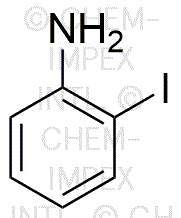2-Iodoaniline is widely utilized in research focused on:
- Synthesis of Pharmaceuticals: This compound serves as an important intermediate in the production of various pharmaceuticals, particularly in the synthesis of anti-cancer agents and other therapeutic drugs.
- Organic Electronics: It is used in the development of organic semiconductors and materials for electronic devices, enhancing the performance of organic light-emitting diodes (OLEDs) and solar cells.
- Dyes and Pigments: 2-Iodoaniline is a key component in the formulation of dyes, providing vibrant colors for textiles and inks, which are crucial in the fashion and printing industries.
- Research in Material Science: The compound is employed in the development of new materials with unique properties, aiding researchers in creating innovative solutions for various applications.
- Analytical Chemistry: It is used as a reagent in analytical methods, helping in the detection and quantification of other compounds, which is essential in quality control processes in laboratories.
General Information
Properties
Safety and Regulations
Applications
2-Iodoaniline is widely utilized in research focused on:
- Synthesis of Pharmaceuticals: This compound serves as an important intermediate in the production of various pharmaceuticals, particularly in the synthesis of anti-cancer agents and other therapeutic drugs.
- Organic Electronics: It is used in the development of organic semiconductors and materials for electronic devices, enhancing the performance of organic light-emitting diodes (OLEDs) and solar cells.
- Dyes and Pigments: 2-Iodoaniline is a key component in the formulation of dyes, providing vibrant colors for textiles and inks, which are crucial in the fashion and printing industries.
- Research in Material Science: The compound is employed in the development of new materials with unique properties, aiding researchers in creating innovative solutions for various applications.
- Analytical Chemistry: It is used as a reagent in analytical methods, helping in the detection and quantification of other compounds, which is essential in quality control processes in laboratories.
Documents
Safety Data Sheets (SDS)
The SDS provides comprehensive safety information on handling, storage, and disposal of the product.
Product Specification (PS)
The PS provides a comprehensive breakdown of the product’s properties, including chemical composition, physical state, purity, and storage requirements. It also details acceptable quality ranges and the product's intended applications.
Certificates of Analysis (COA)
Search for Certificates of Analysis (COA) by entering the products Lot Number. Lot and Batch Numbers can be found on a product’s label following the words ‘Lot’ or ‘Batch’.
*Catalog Number
*Lot Number
Certificates Of Origin (COO)
This COO confirms the country where the product was manufactured, and also details the materials and components used in it and whether it is derived from natural, synthetic, or other specific sources. This certificate may be required for customs, trade, and regulatory compliance.
*Catalog Number
*Lot Number
Safety Data Sheets (SDS)
The SDS provides comprehensive safety information on handling, storage, and disposal of the product.
DownloadProduct Specification (PS)
The PS provides a comprehensive breakdown of the product’s properties, including chemical composition, physical state, purity, and storage requirements. It also details acceptable quality ranges and the product's intended applications.
DownloadCertificates of Analysis (COA)
Search for Certificates of Analysis (COA) by entering the products Lot Number. Lot and Batch Numbers can be found on a product’s label following the words ‘Lot’ or ‘Batch’.
*Catalog Number
*Lot Number
Certificates Of Origin (COO)
This COO confirms the country where the product was manufactured, and also details the materials and components used in it and whether it is derived from natural, synthetic, or other specific sources. This certificate may be required for customs, trade, and regulatory compliance.


